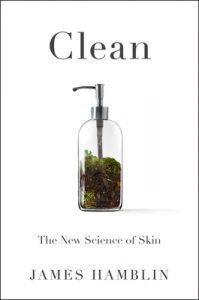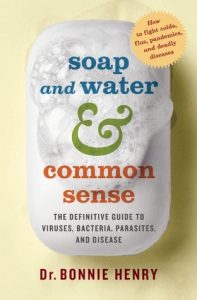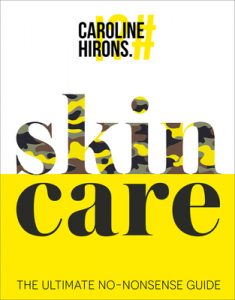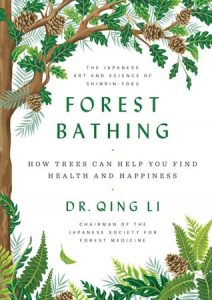 Publishing a book in 2020 in the midst of the COVID-19 pandemic on the topic of cleanliness and how we’re overdoing the clearing off of our skin microbiome, and too often, is… bold. The author, James Hamblin, addresses this in the introduction, as you’ll find no mention of COVID-19 in the pages of Clean (also available on Overdrive as an e-book and an e-audiobook), since this was written before the pandemic hit. Its message, however, makes for even queasier reflection once we start thinking about how much 2020 has seen an uptick in the use of hand sanitizer and soap – and a necessary one, of course! I’m not even suggesting for a moment that we should reconsider how much we’re washing our hands in the midst of a pandemic where washing our hands properly might literally save lives. But similar messages have been raised about how we’re destroying our skin microbiome on a much more frequent basis than might be healthy: Beyond Soap by Sandy Skotnicki, was published back in 2018, for example, along with Missing Microbes by Martin J. Blaser (2014), which talks about antibiotic overuse and how that is changing our relationship with the microbes around us.
Publishing a book in 2020 in the midst of the COVID-19 pandemic on the topic of cleanliness and how we’re overdoing the clearing off of our skin microbiome, and too often, is… bold. The author, James Hamblin, addresses this in the introduction, as you’ll find no mention of COVID-19 in the pages of Clean (also available on Overdrive as an e-book and an e-audiobook), since this was written before the pandemic hit. Its message, however, makes for even queasier reflection once we start thinking about how much 2020 has seen an uptick in the use of hand sanitizer and soap – and a necessary one, of course! I’m not even suggesting for a moment that we should reconsider how much we’re washing our hands in the midst of a pandemic where washing our hands properly might literally save lives. But similar messages have been raised about how we’re destroying our skin microbiome on a much more frequent basis than might be healthy: Beyond Soap by Sandy Skotnicki, was published back in 2018, for example, along with Missing Microbes by Martin J. Blaser (2014), which talks about antibiotic overuse and how that is changing our relationship with the microbes around us.
 Hamblin takes us through the history of soap and how it got to be perceived as a necessity, along with how its own marketing nowadays walks a dangerous line between calling itself out as unnecessary and trying to sell itself to you as the newer, better (gentler) version of a traditional soap! Using the example of how Dove was marketed as it hit the markets, Hamblin illustrates the beginnings of this turning point when new soaps were advertised as like soap, but not soap, and better as a result of being not soap. The unintended consequence of that, of course, was that consumers started having doubts as to whether soap was necessary (in the pursuit of the good) or sufficient (think of how soap, drying your skin and your hair, requires that you use conditioner and moisturizer to restore the lost moisture). Dove’s slogan was: “Looks like a soap, it’s used like a soap – but it’s not a soap” and: “Dove won’t dry your skin like a soap.” (Hamblin, Clean: III. Lather). This is because Dove contains a moisturizer to make sure it was (and remains) less drying… but it also made its cleaning properties less effective:
Hamblin takes us through the history of soap and how it got to be perceived as a necessity, along with how its own marketing nowadays walks a dangerous line between calling itself out as unnecessary and trying to sell itself to you as the newer, better (gentler) version of a traditional soap! Using the example of how Dove was marketed as it hit the markets, Hamblin illustrates the beginnings of this turning point when new soaps were advertised as like soap, but not soap, and better as a result of being not soap. The unintended consequence of that, of course, was that consumers started having doubts as to whether soap was necessary (in the pursuit of the good) or sufficient (think of how soap, drying your skin and your hair, requires that you use conditioner and moisturizer to restore the lost moisture). Dove’s slogan was: “Looks like a soap, it’s used like a soap – but it’s not a soap” and: “Dove won’t dry your skin like a soap.” (Hamblin, Clean: III. Lather). This is because Dove contains a moisturizer to make sure it was (and remains) less drying… but it also made its cleaning properties less effective:
That is, the product becomes closer to nothing (Hamblin, Clean: III. Lather)
 This bit of doubt – that soap by itself was insufficient – was what was needed for the growth of something that will likely be very familiar to most of us today: the skincare industry.
This bit of doubt – that soap by itself was insufficient – was what was needed for the growth of something that will likely be very familiar to most of us today: the skincare industry.
Reading through the section on the self-care and skincare industry was actually pretty terrifying, to be honest, as someone who engages with that industry as a consumer. The complete lack of regulation (in the States – apparently Canada and the EU do significantly better, in that at the very least they have been “reviewing ingredients in personal care products for decades”, which has not been happening in the States(!?)) would probably make me second-guess how much I trust the already grandiose claims of some skincare products, along with being even more critical of those labels: “natural” and “eco” or “green”. Hamblin does make an astute observation when he notes that “many people come to the skin care space because the medical establishment has failed to address their concerns… the skin care industry promises hope and a sense of control” (Hamblin, Clean: IV. Glow). If you’ve been failed by the medical establishment for skincare issues at any point in time (persistent acne, for example), you probably agree with Hamblin on that count. And when the skincare product does better than your prescribed antibiotic, who cares, really, whether it was getting off the antibiotic or that it was actually thanks to the skincare product that things improved? The important thing (for the consumer anyway) is that it worked. Hence the cult nature of certain products, despite the lack of scientific studies to prove their efficacy. That said, the nature of everyone’s skin being different means that even if a beloved product works for a certain subset of the population with a certain skin issue, it might not work for everyone, which is surely part of why there are a billion options available for any particular ailment that the skincare industry can hope to target their products at. Which, you might agree, is incredibly stressful to be sifting through, especially when you learn about the lack of regulations in this game. And then you start thinking about how all that stress is negatively impacting your health, causing you to stress even more…
 Doing a bit of a sharp turn here towards the benefits of being in proximity to nature, since one of the great things about fresh air* is that it can help decrease your stress levels. In fact, it’s not like it’s news to us that productivity increases after taking a short break out in nature, and with so many of us working from home more than before, taking that short walk outside might just be the trick to getting that document you’ve been working on finally completed. (Keeping in mind the stay-at-home order of course, so outside might just mean your front or backyard if you have one.) One example of this being put into practice is with forest bathing, a scientifically studied way to reduce stress and improve a whole suite of things, including your mood and your health, decreasing anxiety, depression and more!
Doing a bit of a sharp turn here towards the benefits of being in proximity to nature, since one of the great things about fresh air* is that it can help decrease your stress levels. In fact, it’s not like it’s news to us that productivity increases after taking a short break out in nature, and with so many of us working from home more than before, taking that short walk outside might just be the trick to getting that document you’ve been working on finally completed. (Keeping in mind the stay-at-home order of course, so outside might just mean your front or backyard if you have one.) One example of this being put into practice is with forest bathing, a scientifically studied way to reduce stress and improve a whole suite of things, including your mood and your health, decreasing anxiety, depression and more!
*Where air pollution isn’t an issue anyway.
In fact, fresh air is such a boon to our health that in the 1800s, when hospitals were still “where people went not to be healed but to suffer and die… a sort of anteroom to hell – or heaven, sorry, heaven” (Hamblin, Clean: IX. Refresh), Florence Nightingale, a nurse, significantly improved conditions of the patients at a military hospital by directing the British Sanitary Commission to “carve new doors and windows to get the breeze flowing through the rooms. Almost instantly the condition of the men improved”. Nightingale argued for better ventilation, drainage, more space between patients, exposure to nature, but not long after, germ theory became recognized and sterility the name of the game. Hamblin argues that, as what happens when we clean everything off our skin with soap, that it’s not just clearing microbes that are bad for us, but also the good and innocuous ones (besides which many issues are not caused just by bad bacteria settling in so much as an imbalance of organisms that already exist in your microbiome), and when we make that real estate available, that allows bacteria that negatively impact our health to have space to jump in just after having cleared out our natural skin defense unit (the good and neutral microbes).
This microbial world makes clear that health is a balance – balance between personal and public health; balance between being too exposed and too isolated. (Hamblin, Clean: IX. Refresh)
Clean is a rollercoaster ride through the history of the concept of cleanliness and is sure to make you take a closer look at your daily routines from a new perspective! Place yourself on hold for the physical item or the e-book or e-audiobook available on Overdrive today!
For more about microbes living in tandem with you on/in your body, check out Follow your Gut by Rob Knight, a compact TED talk book that discusses the gut microbiome and how it affects not just our digestive system but the rest of our body. I reviewed this title here, and would still recommend it as a quick intro that you can flip through to learn more about how microbes and our bodies have a much more complex relationship than we could ever have imagined. Some more titles for those of you interested in learning about microbes include I Contain Multitudes by Ed Yong (2016) and Microbes by Phillip K. Peterson. And if you’re more interested in learning about our largest organ, our skin, check out The Remarkable Life of the Skin by Monty Lyman!